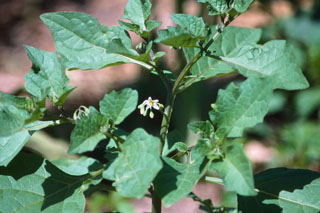BLACK NIGHTSHADE
|
 |
| File Size: 133 KB |
|
|
|
Solanum ptychanthum Dunal
|
| Grant County, Kansas (Marion McGlohon photo) |
| Annual |
| Height: (4-)12-24(-48) inches |
| Family: Solanaceae - Nightshade Family |
| Flowering Period: May, June, July, August, September,October |
|
| Stems: | | Ascending, much-branched, glabrous, glabrescent or, if puberulent medially or distally then with hairs not uniformly distributed, often in lines or irregular patches. | | Leaves: | | Cauline, alternate, simple; petiole .4 to 4 inches; blade ovate, ovate-lanceolate, lanceolate, or elliptic, .8 to 6 inches long, .4 to 3.6 inches wide, margins entire to undulate or sinuate-dentate. | | Inflorescences: | | Umbels, axillary, 2-8-flowered. | | Flowers: | | Calyx .04 to .06 inch, 5-lobed, lobes lanceolate to oblong; corolla white, rarely bluish, .3 to .6 inch wide, 5-lobed, lobes ovate to lanceolate, spreading to reflexed, .05 to .07 inch; stamens 5, of one form, erect, fused to corolla tube, connivent around style; anthers yellow, .06 to .08 inch; pistil 1; style 1. | | Fruits: | | Berries purplish black, .2 to .35 inch diameter, proximal 1/3 covered by prickle-less calyx. Seeds yellow to brown, nearly round, .06 to .07 inch, minutely pitted or reticulate. | | Habitat: | | Roadsides, pastures, stream banks, prairie ravines, moist woodlands, waste areas. | | Distribution: | | Throughout Kansas | | Origin: | | Native | | Toxicity: | | Many species of Solanum are poisonous, either when fresh or when dried. They produce a variety of glycoalkaloids, the concentrations of which can vary with plant part, plant age, and environment. Symptoms of nightshade poisoning include mild to severe gastrointestinal irritation, stupefaction, and loss of sensations in humans, and drowsiness, salivation, dyspnea, trembling, progressive weakness or paralysis, prostration, and unconsciousness in animals (Kingsbury 1964). Poisoning may or may not be fatal. | | Comments: | | The herbage is green, not stellate-pubescent, glabrous to sparsely strigose, not viscid, not prickly. Solanum, possibly to quiet, alluding to the sedative effects and ptychanthum, folded and flower. |
|
| Black nightshade habit |  | | 200 KB | | Grant County, Kansas (Marion McGlohon photo) |
| | | | |
|
|
|
|
|
|



